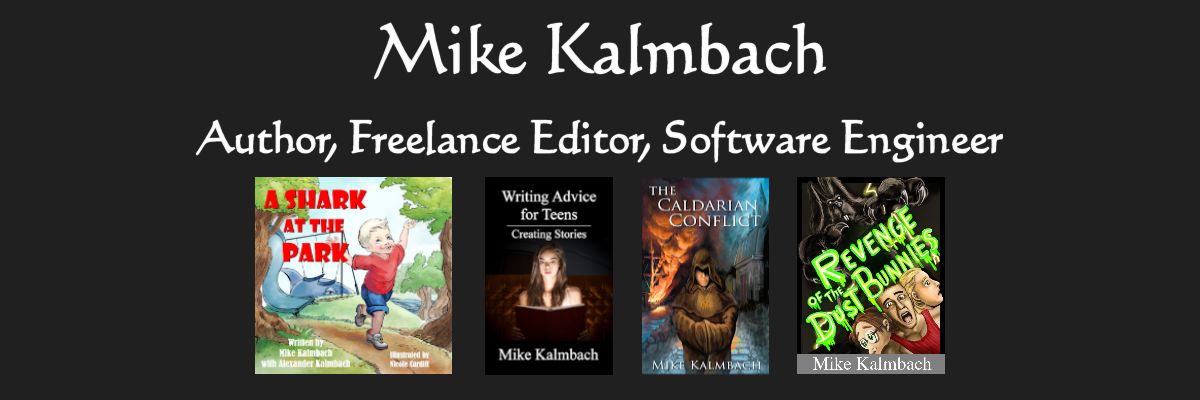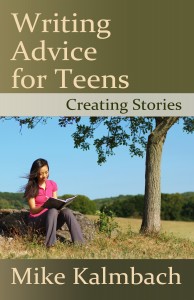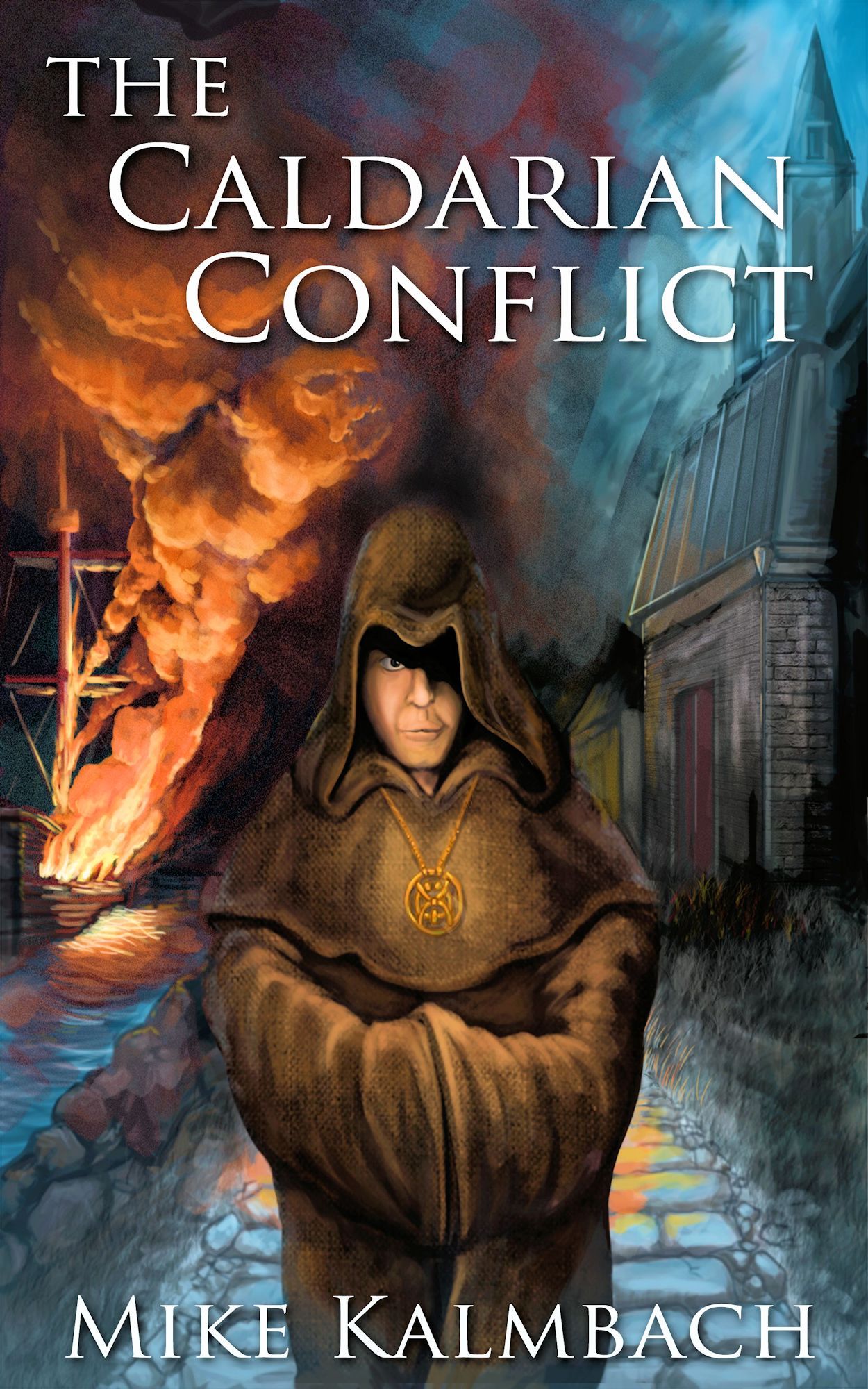Announcing: Writing Advice for Teens: Creating Stories
Posted on March 18th, 2012
My next book, Writing Advice for Teens: Creating Stories, is now available for preorder from Amazon. I’m pretty excited!
This book is the first in a series of non-fiction books designed to help teen writers through all the stages of writing, from creating stories to writing as a career. It’s great for new writers of all ages, and is organized into an easy-to-read format with plenty of examples and exercises.
As well as accepting preorders through Amazon, I’m also looking for early reviewers who will read the book and write a review in time for its April 24 launch. Readers will receive a free PDF of the book, and as might be obvious, should not distribute the file to anyone else. Simply comment on this blog post, post a message on my Facebook Author page, or send me a tweet via Twitter (@mikekalmbach).
If you’re on Goodreads, take a moment to add Writing Advice for Teens: Creating Stories to your to-read list.
Thanks for helping get a new book off the ground!
How to Best Support an Indie Author
Posted on October 5th, 2011
Did you just read an awesome indie book? Are you looking for ways to help the author out?
You’ve come to the right place.
What follows are several methods to help an indie author out. This includes:
- Buying the book (first for yourself, then as gifts for friends)
- Telling your friends (and posting reviews)
- Tagging the book to make it easier for people to find
While (perhaps obviously), I’m targeting this to my own fans, these strategies are general enough for any indie author. I’d expect the actual dollar values should be consistent for most indie authors as well.
Buy the book
Of course, the first and best way is to buy a copy of the author’s book. However, where you buy it is as important as your actual purchase.
Paperbacks:
Since I published through CreateSpace, I earn the most when people buy direct from them (about $4.50 per book from my $10.95 book). Amazon falls in at a respectable $2.94. However, when someone buys a copy from Barnes and Noble, I earn only $0.25 per book.
Buying the book as a gift is an excellent way to thank an author. That’s part of the reason I offer signed copies through my site (check the right-hand panel)–it’s an opportunity for fans to purchase a unique gift for themselves or their friends. Since I include a free ebook with autographed paperbacks purchased through my site, you can buy a paperback as a gift and keep the ebook for yourself.
Giving the book as a gift offers you the opportunity to talk with others about the book, which helps get the word out for an indie author.
Ebooks:
As an indie author, Smashwords gives me the best return: about $2.21 per book. Amazon is second, at about $2.03 a book, and Barnes and Noble gives me $1.94 per book. Besides offering the best return, Smashwords also lets me run coupons as needed. If I want to give a free copy to a book reviewer, all I have to do is generate a code and pass it along.
Lending an ebook to a friend also helps spread the word about a good book, so take advantage of this opportunity. Which leads us to the next point:
Tell your friends
Think about the last book you bought. Why did you buy it?
Chances are pretty good that it’s because a friend recommended it.
Word of mouth advertising is awesome. If you can’t stop raving about the plot twists in The Caldarian Conflict, (as a completely random and unbiased example), people take notice.
If you’re part of a book group, suggest that the group read a book by the indie author. Note: only do this if you’d give the book a 4- or 5-star review. And make sure the book is free of typos. When the average reader spots typo after typo, the book probably wasn’t ready to be released.
Did I just mention reviews?
That’s another great way to help out an indie author. Thoughtful reviews are more important than 5-star reviews (though as an indie author, I always love to receive a 5-star review). That said, when someone checks out a book’s rating on Amazon, they’re more likely to purchase a book that has several thoughtful reviews than several that say: “This book is teh best!!!” (typo intentional)
When reviewing, do explain what you liked and who might be most likely to enjoy the book. Try to avoid spoilers where possible. Post it everywhere the book is sold, and especially on reader communities like Goodreads or LibraryThing.
Once you’ve written a review, tell people on Facebook and Twitter about the book. When they know you wrote the review, your friends or followers are more likely to at least look at the book to see whether it’s a good match.
While we’re talking about Facebook and Twitter, definitely become a fan of the author and follow their tweets. When you see something interesting from the author, pass it along to your friends so the author can grow followers and potentially connect with other readers.
Tag the book
What is tagging?
Tagging is a method of adding keywords to a book so that it shows up in search results. The more people that agree with a particular tag, the higher the placement of the book in the search results.
Tags can usually be found on a product’s Amazon page. Other sites use tagging sometimes, but Amazon is the most widely used. Simply search for “tag” on the page, and you should find it.
If there’s nothing there, add tags related to the book. For example, some of the tags currently used for The Caldarian Conflict include pirates, monks, and corrupt government. If you have read the book, select the check box for those you agree with. If you happen to think of others that aren’t listed, definitely add them. The author will certainly appreciate it when others find (and hopefully purchase) their book.
If you’ve already read my book, please go to the Amazon page and help me out with a review and adding some tags. I’d really appreciate it.
What other ways can you think of to help an indie author out? What did I miss?
Sales results – Month 1 as an indie author
Posted on October 1st, 2011
This is my first monthly report on how sales are going for my book. Eventually I’ll include multiple books as I release them.
Why release my numbers publicly?
By sharing this publicly, I hope it helps other indie authors set expectations, plus it helps me maintain a monthly record of what I’ve done and what the results were.
—–
Book Title: The Caldarian Conflict (preview)
Current Rating: 4.5 stars with six reviews on Amazon
Pricing: $2.99 ebook, $10.95 paperback
Favorite quote from a review: “I was literally up all night because I couldn’t stop reading (if there are any typos in this review blame them on my blurry vision).” – Maxine McLister (Amazon)
This month’s goal: 100 books sold (ebook & physical)
Total sales: 124 books sold – 50 ebooks and 74 paperbacks
Promotional copies: 41 ebooks + 12 paperbacks (not included in sales)
—–
I’m pretty pleased with the results. Exceeding my goal for first month’s sales is pretty awesome–especially since I had no measurements to guide my estimate.
My biggest surprise? That physical books outsold the ebooks this month. With everything I’ve read, and the lower price point on the ebooks, I expected ebooks to far exceed paperbacks.
That said, it’s probably a result of the heavy marketing I did. The single biggest day of sales was 43 paperbacks at my launch party.
At this point, I think it’s most effective for me to allow people time to read the book and (hopefully) write reviews. With the exception of occasional tweets and Facebook posts, I plan to focus most of my spare time on writing additional material.
I’m also planning to point out that signed copies of The Caldarian Conflict make a great unique gift for fantasy fans. (hint hint: check the right-hand panel for ordering autographed copies, or buy from Amazon, Barnes and Noble, CreateSpace, or Smashwords)
In October, I plan to invest a lot of time working on my next two projects. With luck, I’ll finish the first draft of at least one of them by year-end.
Next month’s goal: 50 books (ebook & physical), due to spending much less time marketing
What do you think? Should I continue focusing on writing more material? Or are there other marketing avenues that I should pursue?
What I’ve Learned So Far as a Self-published Author
Posted on September 15th, 2011
I’ve been a self-published author for about three weeks, so it’s time to take my wealth of wisdom and share it with the world.
Preparation
There are a few steps you need to take before you can make your book available to the world. Beyond the obvious revisions and editing, you also need to format your manuscript so it looks correct on ebook readers and print versions. In my case, I have separate files for each format. If a reader tells me that there’s a typo, I’ll need to update each file with the fix and submit it individually to each publisher.
That brings me to my next point. Even before you can format, you have to decide where you’re going to release your book. I have four places in my case: Amazon, Barnes and Noble, CreateSpace, and Smashwords. Each one needs a different ISBN, so I ended up buying a block of 10, which allows me to prepare for my next book that will be released sometime next year.
After you’ve got your work in finished form, you need to register your copyright. Go to http://copyright.gov to do so–if you’re creating a print version, you’ll need to mail two copies of the book in order to register your copyright. ebooks can simply be uploaded after you’ve paid the $35 fee.
Marketing
This is the biggie. I’m trying several different avenues, including:
- obtaining a live TV interview with KTTC (link to come)
- creating a YouTube book trailer
- posting on social websites, including Reddit and Twitter
- participating in a Facebook group for my book
- submitting to multiple book reviewers
- hosting a launch party in Rochester MN on September 19
- signing at an author event in Rochester on September 24
- sponsoring a Goodreads giveaway of 5 signed copies of my novel
- spreading my press release to several area newspapers, many of whom published it verbatim
- securing a feature article in the Minnesota Writers Alliance newsletter
- accepting preorders on my own site, and including a free ebook with purchase of an autographed novel
- requesting honest reviews from family and friends
- reviewing indie books and connecting with other indie authors
There are many other opportunities (and probably a few things I’ve missed that I’ve done), and I’m trying a lot of different things. However, by far the best way to get additional sales has been for those who enjoy the book to talk about it with others. Word of mouth is amazing at selling books. A few vocal readers have done a lot to help get my work out there.
As a related aside, I’d love to get my novel into book clubs (The Caldarian Conflict is a fantasy novel, so fantasy book groups would be best for me), so if you have any advice on that, let me know in the comments below.
The biggest issue I’ve found is that many people presume a self-published novel will be low quality. This is hard to change. However, since I know people are concerned about quality, I offer them a free preview of the book so they can decide for themselves. Many of those who read the preview ended up buying the book.
Keep writing
By my estimation, it’s possible to make a reasonable living by selling between 75 and 100 books per day. Since at the moment I’m only selling about 2-3 books per day, that’s a pretty far stretch. However, by writing more books, suddenly it becomes much easier to achieve that goal.
Example:
- With one book, you might need to sell 75-100 copies per day.
- With two books, you might need to sell 35-50 copies of each book per day.
- With ten books, you only need to sell 7-10 copies of each book per day.
And so on.
So while I’m spending a majority of September taking advantage of the time to market my debut novel, I’m going to spend October and November finishing up the draft of a second. With a little luck and a lot of work, I should be able to release the new novel by mid-next year. I also have a few short stories I may decide to release in the interim.
That’s all I’m planning to divulge tonight. What do you think? Am I missing something? Or are there other areas to explore?


